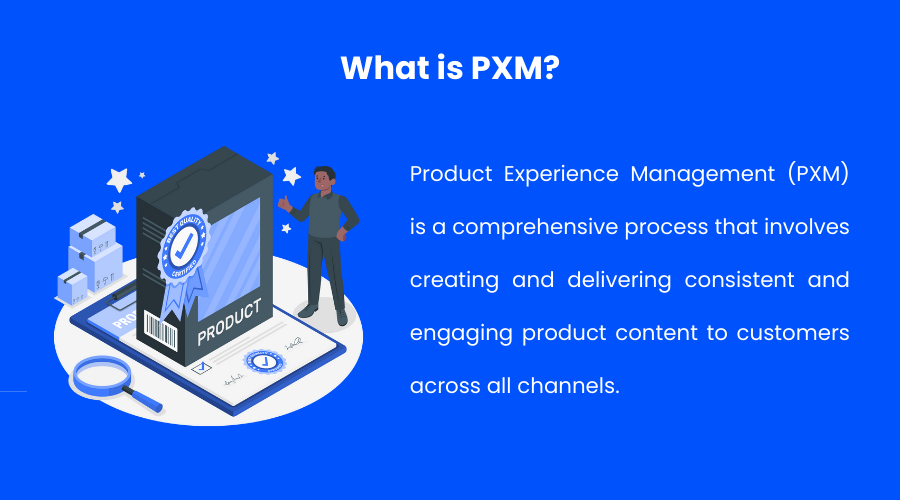In today’s fast-paced world, the need for effective product information management has become more critical than ever. The sheer volume of data companies can be overwhelming, making it difficult for businesses to manage and distribute accurate and up-to-date product information to their customers. This is where Product Experience Management (PXM) comes into play.
In this blog, we will explore what is PXM, how it differs from PIM, and how it can help businesses improve customer experience and drive sales. Whether you are a small business owner or a large enterprise, this blog will provide you with the knowledge and tools to enhance your product information management strategy with PXM.
What is PXM?

Product Experience Management (PXM) is a comprehensive process that involves creating and delivering consistent and engaging product content to customers across all channels.
The aim of PXM is to provide customers with a seamless and enjoyable experience that showcases the product’s value and builds their loyalty to the brand.
Product Experience Management (PXM): The Key Components
Businesses need to make use of a variety of technologies and tools in order to manage the product experience effectively.

Here I’m highlighting the key components of PXM so that you can better understand what is PXM.
1. Product Information Management (PIM)
PIM is the foundation of PXM and is responsible for managing product information, such as descriptions, specifications, and pricing.
It allows businesses to efficiently manage product information and deliver it to various sales channels, including eCommerce websites, marketplaces, and print catalogs.
Looking for an all-in-one PIM solution that simplifies your product content management?
Get started with Apimio PIM today and start achieving your business goals seamlessly.
2. Digital Asset Management (DAM)
DAM is a system for organizing and managing digital assets, such as images, videos, and documents.
DAM is an important component of PXM because it enables businesses to create rich, engaging product experiences by incorporating high-quality visual and multimedia content.
3. Content Management System (CMS)
CMS is a system for managing and publishing digital content, such as web pages, blog posts, and marketing materials.
A CMS is an essential component of PXM because it enables businesses to create and publish content that supports the product experience and helps to build brand loyalty.
Why is Product Experience Management (PXM) important for businesses?
There are many reasons why businesses need PXM. Here I have highlighted some of the primary reasons why PXM is important for businesses;

1. Enhanced Customer Experience
PXM helps businesses in providing customers with a consistent experience across all channels. It enables businesses to manage product information in a centralized location and distribute it uniformly across all platforms. 1
In this way, businesses can ensure customers receive the same experience and message regardless of the channel they use. Customers can make more informed purchasing decisions because of this consistency, which builds trust.
2. Increased Revenue
PXM has the potential to significantly boost sales by providing customers with relevant and accurate product information.
This is because customers are more likely to purchase when they can access comprehensive and eye-catching product information.
PXM also helps businesses use cross-selling and upselling opportunities by suggesting relevant products to customers.
3. Enhanced Image of the Brand
PXM enables businesses to establish a strong brand image by providing customers with a smooth and seamless experience. 2
Businesses can also improve their market reputation and build customer loyalty by consistently providing high-quality product information across all channels.
4. Enhanced Productivity
PXM streamlines the process of managing product information by centralizing it in one location. Businesses can save time and resources by reducing the need for manual data entry and distribution.
By providing a shared platform for managing product information, PXM also enhances department and team collaboration.
PXM vs. PIM: How do they differ?
PXM aims to create a comprehensive and engaging product experience for customers that goes beyond just providing accurate product information.
It involves delivering the right information at the right time in an attractive and emotional way that creates a strong bond with the customer. Businesses can improve customer satisfaction, conversion rates, and sales by doing so.
Want to expand into new markets but not sure how to handle localized product information?
Contact Apimio PIM’s experts and see how we can help you achieve your goals.
Although PIM remains a critical component of PXM, it is only one part of the overall strategy. PIM focuses on centralizing and improving the quality of product-related information, while PXM is responsible for using that information to tell a compelling product story.
This involves enriching and contextualizing the product content to make it more appealing to customers and more likely to drive sales.
Product Experience Management (PXM): The Main Challenges
Sometimes, the challenges lie in the benefits. The reader will get an overview of the product in a few minutes, but you will need much more time to create an appealing image of the product.

The common challenges lie within PXM are;
1. Organizing a structured workflow
Implementing PXM requires a defined and structured workflow that involves all stakeholders, including product managers, marketing teams, and content creators.
The challenge lies in creating a workflow that ensures consistency, accuracy, and timeliness of product information across all channels.
2. Data distribution across channels
The next challenge is distributing product information across the right channels and in the right format. Each channel has different requirements, and the content needs to be optimized accordingly.
This requires a deep understanding of the target audience and the channel’s characteristics.
3. Updating content according to new insights
Another challenge is keeping the product information up to date based on new insights and customer feedback. This requires continuous monitoring and analysis of customer behavior, market trends, and competitive landscape.
The challenge lies in balancing the need for timely updates with the need for accuracy and consistency.
4. Managing multiple languages and regions
If you sell products in multiple languages and regions, you will be challenged to manage multiple versions of the same product information.
This requires a robust translation and localization process that ensures consistency and accuracy across all languages and regions.
5. Integration with existing systems
Integrating PXM with existing systems such as ERP, CRM, and CMS can be a challenge. It requires a deep understanding of the data architecture and the ability to seamlessly extract and transfer data between systems.
PXM and Ecommerce: How it plays a role?

PXM (Product Experience Management) is increasingly becoming a critical factor in the success of ecommerce businesses. It helps e-commerce companies create an engaging and seamless product experience for their customers regardless of the channel they use.
It enables businesses to enhance the customer experience, improve product discovery, and drive sales 3 by providing accurate and detailed product information, optimizing product content for various channels, and supporting internationalization.
Additionally, PXM offers businesses a centralized platform for managing product data, images, and videos, which can simplify the product management procedure and conserve time and resources.
With the growing competition in the ecommerce industry, PXM can provide businesses with a competitive edge by helping them deliver a more consistent and compelling product experience.
Conclusion
In order to give customers a seamless and engaging experience, Product Experience Management (PXM) needs to be given priority. This can be achieved with the help of reliable Product Information Management (PIM) software, such as Apimio PIM.
PIM allows for easy localization of product attributes, with language variations and adjusted currencies, ensuring businesses can easily expand into new territories. Businesses can manage their product information and provide a compelling product experience by utilizing Apimio PIM, resulting in increased sales and customer loyalty.
What to do next?
- Read more about our Product Information related Guides here.
- To see the difference PIM can make to your e-commerce business, start exploring.
- If you have any additional questions or concerns, please don’t hesitate to Contact our support.
Frequently Asked Questions
PIM is responsible for centralizing and improving the quality of product-related information, which is a critical component of a successful PXM strategy.
PXM assists businesses in establishing a consistent and engaging customer experience for their products across all channels, resulting in increased sales, customer loyalty, and satisfaction.
PXM involves creating and distributing consistent, engaging product content to customers to drive sales and build loyalty, whereas PIM focuses on centralized information management and improving quality.



